Identification of dismembered, mutilated and fragmentary human remains encountered in cases of mass disasters, criminal mutilation, explosions, homicides, air plane crashes, traffic accidents, assault cases etc., is of utmost importance in any forensic investigations and has been a major challenge for forensic experts and physical anthropologists. Besides various parameters of identification (i.e., race, age and stature), gender estimation from the human body parts and skeletal remains is an essential component of personal identification in medico-legal investigations [1,2]. The key indicators of identification like race, gender, age, and stature can be determined by somatometry, osteologic and radiologic examination of hands. In both genders, age of fusion of epiphysis differs. Hence, estimation of gender from hand and foot dimensions can also benefit the forensic scientist in identification of dismembered, mutilated and fragmentary human remains [3,4]. Various studies have reported that when an individual hand or foot is found accidentally and carried for analysis, the dimensions of hand or foot can afford useful information regarding the stature, gender and age of the person [1]. Various researches have been carried out by different authors for the estimation of stature [5-9] from the measurements of hand and foot, fingers and phalanges length, small bones of the hand and foot, foot prints etc., by means of statistical equations and formulae [1]. The aim of the present study was to determine whether index/ring finger length ratio, hand and foot index, as well as their correlation could be used in gender estimation.
Materials and Methods
A descriptive cross-sectional study was conducted on 300 subjects at IDST College, Modinagar, Uttar Pradesh, India. The study was restricted to dental students and dental professionals.
The required sample size was calculated based on the results of a pilot study data taking prevalence of 73.5%. Required sample size based this was 300.
This study was done with the intention to see the feasibility within the college premises as this study sample was easily accessible.
Hand length, breadth and hand index, Index Finger Length (IFL), Ring Finger Length (RFL) and IFL/RFL ratio as well as foot length, foot breadth and foot index was estimated in millimeters (mm) by using a sliding-anthropometric caliper. The subjects with the following were excluded from the study; deformity or any disease, any injury, fractures and amputation or a history of any surgical procedure on their hands/feet. All the measurements were taken by one observer on right and left hands/feet so as to avoid inter-observer bias. This study was approved by Ethical Committee of IDST College, Modinagar. An informed consent was obtained from the study subjects for the study.
Hand measurements were obtained by asking the subject to place their hand on a flat surface with palm facing upwards (i.e., supine position), fingers extended and close to each other. Care was taken to avoid abduction or adduction at the wrist joint and the forearm was directly in line with the middle finger. Hand length was measured as a projected distance between distal crease of wrist joint and the most anterior projecting point, i.e., tip of middle finger. Hand breadth was estimated as a projected distance between the most laterally placed point on the head of second metacarpal bone to the most medially placed point situated on the head of fifth metacarpal bone [Table/Fig-1]. The hand index was calculated by dividing the hand breadth by hand length and then multiplied by 100 (breadth divided by length × 100). The index finger length was measured as a straight distance between the proximal most metacarpo-phalangeal creases to the tip of the index finger. The ring finger length was obtained as a straight distance between the distal metacarpo-phalangeal creases to the tip of the ring finger [Table/Fig-2]. The index and ring finger ratio was calculated by dividing IFL by RFL.
Human hand showing landmarks of Index Finger Length (IFL) and Ring Finger Length (RFL).
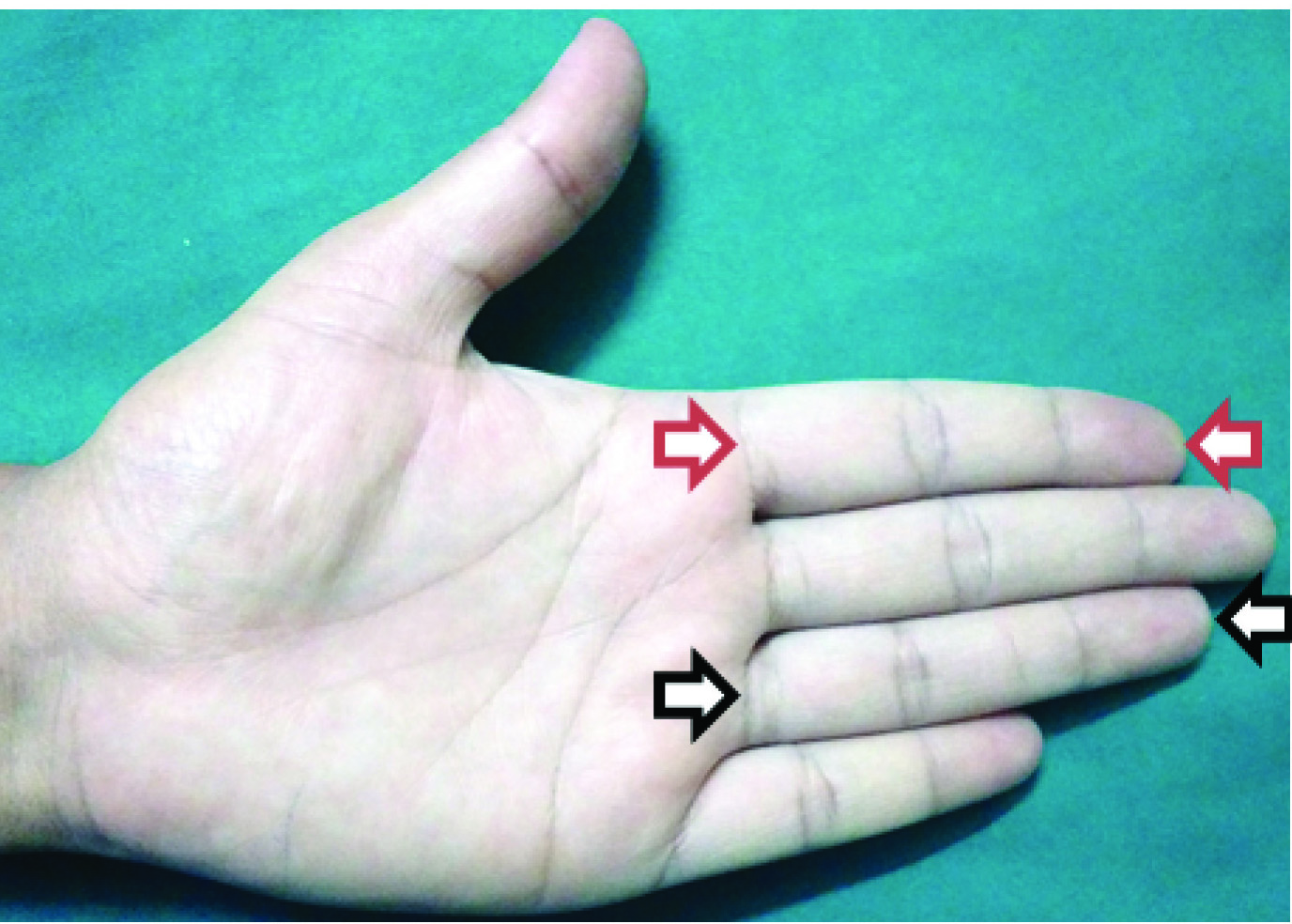
Human hand showing landmarks of hand length (AB) and hand breadth (CD).
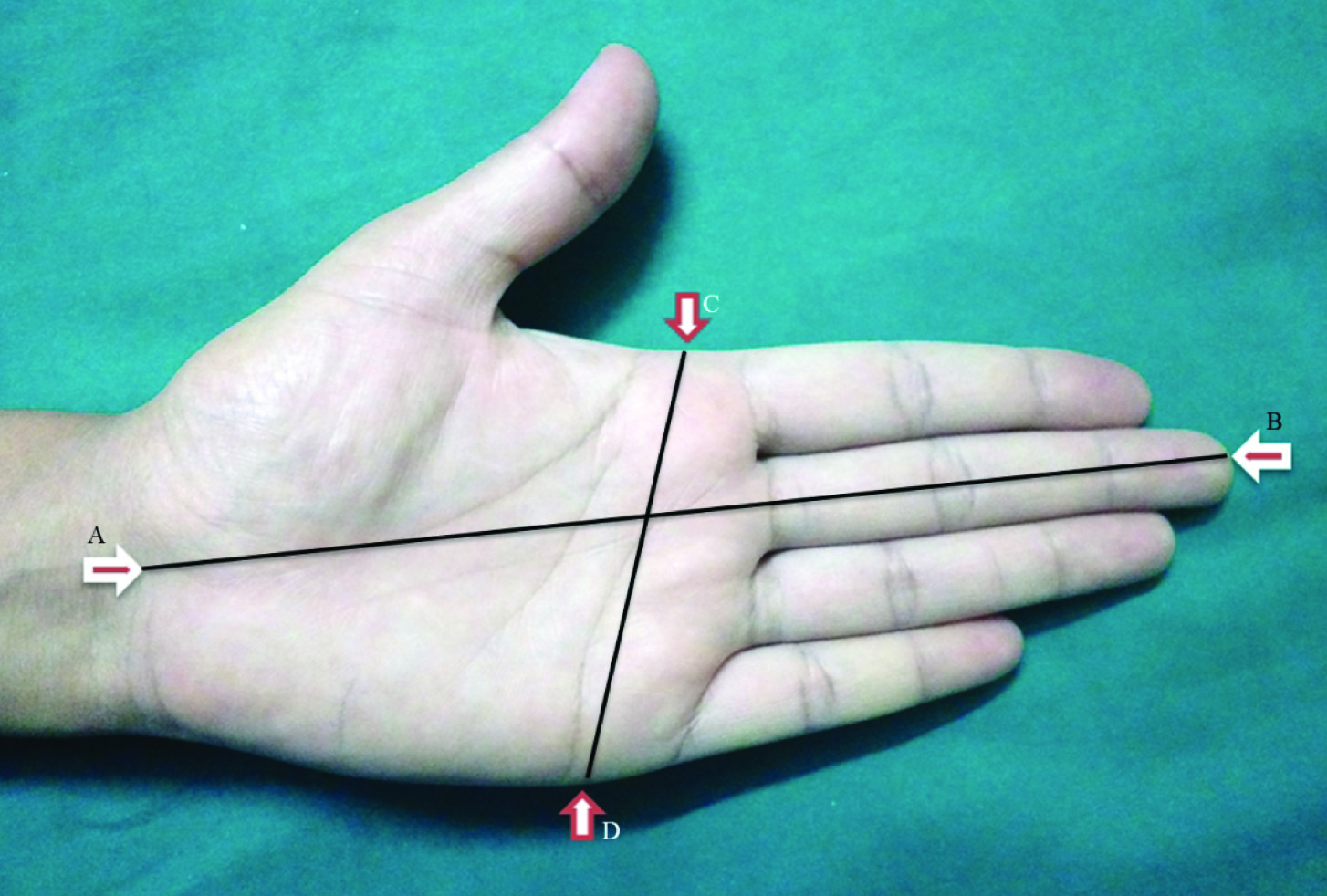
Foot measurements were obtained by asking the patient to sit on a chair with his/her leg being slightly bent and measurement was taken with the help of sliding caliper on the inner surface of the foot. Foot length (FL) was calculated as the distance between the most posterior point of the heel (pternion) to the most anterior point of the longest toe (first or second). Foot breadth was measured as the distance between the most prominent point of the inner side of the foot (metatarsal-tibiale), and the joint of the anterior epiphyses of the fifth metatarsal, the most prominent point of the outer side (metatarsal-fibulare) [Table/Fig-3].
Human foot showing landmarks of foot length (EF) and foot breadth (GH).
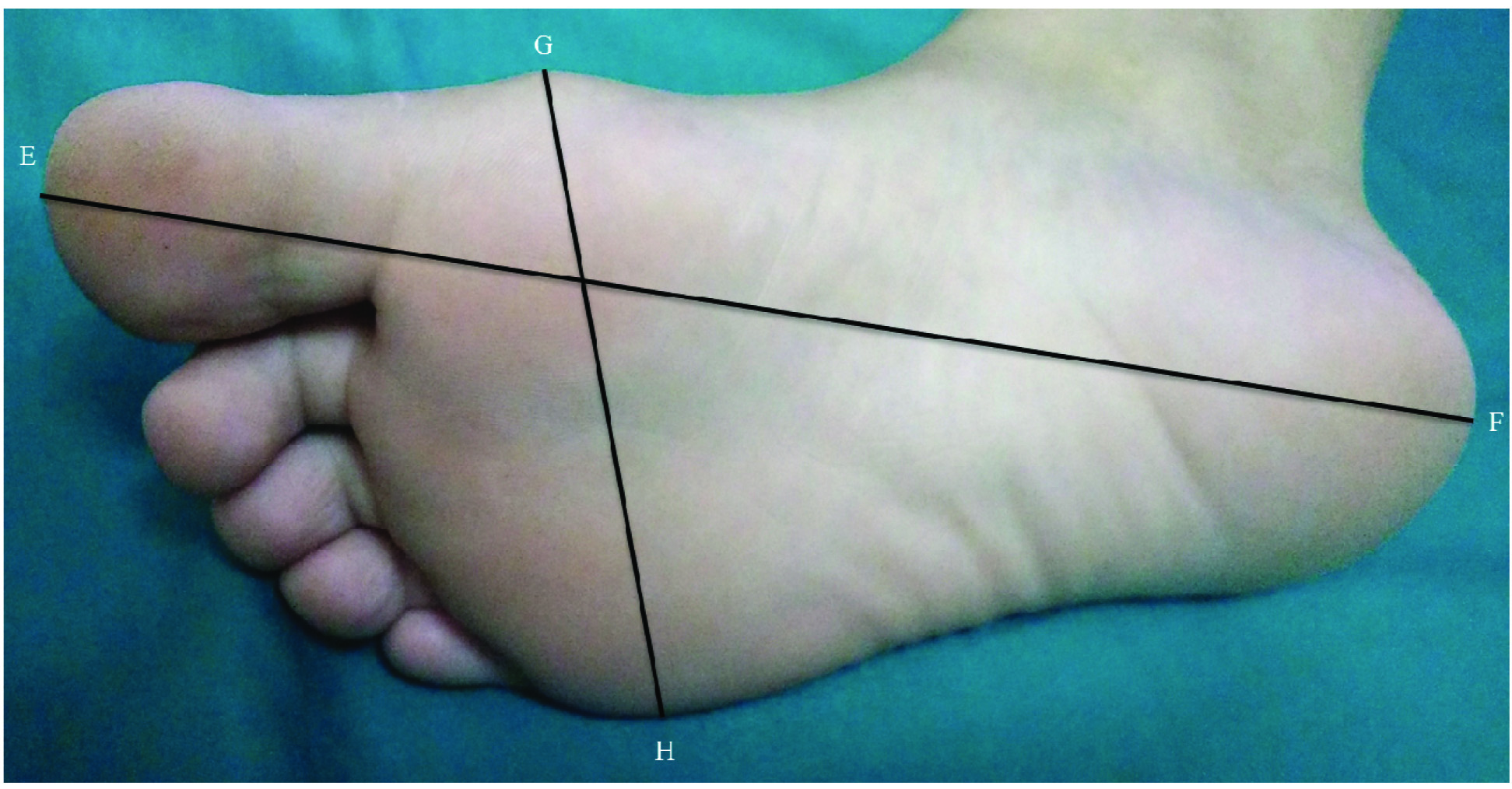
Statistical Analysis
Statistical analysis was done to determine the significance of findings observed between both the genders using statistical software (SPSS version 19.0). Mean, standard deviation and standard error of mean were calculated. They were compared by using the test of significance i.e., independent t-test. Pearson correlation coefficient test was done to observe the correlation between the hand and foot index. A probability value (p) of ≤ 0.05 was considered to be statistically significant. Average of mean IFL/RFL ratio, hand and foot index of both genders was taken for gender estimation of the subject, and was known as the “sectioning point”. A dividing line (Cutoff point) for IFL/RFL ratio, hand and foot index between the genders was attained, on the basis of sectioning point and by “trial and error” analysis.
Results
The mean age of the males and females was 24.35 years and 23.07 years respectively. Descriptive statistics of IFL, RFL and index/ring finger length ratio (IFL/RFL) for both hands in males and females were shown in [Table/Fig-4]. In males, the mean RFL was greater than mean IFL in females. The index and ring finger length ratio was found to be higher in females as compared to males. The index and ring finger length ratio between males and females was statistically significant (p≤0.001) for both hands but the difference between left hand IFL/RFL ratio and right hand IFL/ RFL ratio was not significant (p-value = 0.536) in females. On the basis of mean index and ring finger length ratio for both genders, the sectioning point for the index and ring finger length ratio was found to be 0.996 for the right and 0.999 for the left hand. This was done so as to discriminate the male and female hands. By trial and error, a cutoff point ratio of 0.99 was obtained to determine the sexual dimorphism of the ratio. The cutoff point ratio of ≤ 0.99 was indicative of males and the cutoff point ratio of ≥ 0.99 was suggestive of females for both hands.
Descriptive statistics of index finger length (mm), ring finger length (mm) and index/ring finger length ratio for both hands in males and females.
| Hand | Right Hand | Left Hand |
|---|
| Gender | Male (n=150) | Female (n=150) | Male (n=150) | Female (n=150) |
|---|
| IFL | RFL | IFL/RFL | IFL/RFL | IFL | RFL | IFL | RFL | IFL/RFL | IFL/RFL | IFL | RFL |
|---|
| Minimum | 61.15 | 62.05 | 0.91 | 0.88 | 56.75 | 52.95 | 60.73 | 61.95 | 0.92 | 0.96 | 55.70 | 53.55 |
| Maximum | 79.95 | 80.15 | 1.07 | 1.13 | 79.95 | 75.15 | 78.55 | 79.95 | 1.07 | 1.08 | 74.25 | 73.15 |
| *Mean | 70.39 | 71.82 | 0.98 | 1.01 | 66.37 | 65.56 | 70.16 | 71.21 | 0.98 | 1.01 | 65.74 | 64.87 |
| SD | 4.21 | 4.11 | 0.017 | 0.021 | 4.00 | 4.03 | 4.16 | 4.17 | 0.015 | 0.016 | 3.89 | 4.05 |
| SE | 0.34 | 0.33 | 0.0014 | 0.0017 | 0.32 | 0.32 | 0.34 | 0.34 | 0.0012 | 0.0013 | 0.31 | 0.33 |
| SP | | | 0.996 | | | | | 0.999 | | |
p ≤ 0.001 (for corresponding male-female values) SD- Standard deviation, SE- Standard error of mean, SP- Sectioning point, IFL-Index finger length, RFL-Ring finger length
Descriptive statistics of the hand length, hand breadth and hand index for both hands in males and females were shown in [Table/Fig-5]. The hand length and breadth was more in males on the right side than in females. The hand index was greater in males on right side as compared to left side. The hand index between males and females was found to be statistically significant (p≤0.001) for both hands. Based on mean hand index for both genders, the sectioning point for the hand index to discriminate the male and female hands was found to be 43.94 for the right and 43.61 for the left hand. By trial and error, a cutoff point of 43.417 was obtained to determine the sexual dimorphism of the ratio. All the cases with cutoff point index for both the hands in females were found to be ≤43.41 and in males to be ≥43.41.
Descriptive statistics of hand length (mm), hand breadth (mm) and hand index for both hands in males and females.
| Hand | Right hand | Left hand |
|---|
| Gender | Male (n=150) | Female (n=150) | Male (n=150) | female (n=150) |
|---|
| Length | Breadth | Index | Index | Length | Breadth | Length | Breadth | Index | Index | Length | Breadth |
|---|
| Minimum | 164.10 | 72.95 | 40.63 | 33.70 | 142.35 | 61.95 | 163.30 | 71.55 | 40.56 | 32.96 | 141.60 | 62.05 |
| Maximum | 194.65 | 92.20 | 50.30 | 48.25 | 191.85 | 84.95 | 194.15 | 92.10 | 50.00 | 47.76 | 189.85 | 84.70 |
| *Mean | 180.97 | 83.25 | 46.04 | 41.84 | 171.31 | 71.50 | 179.79 | 82.06 | 45.69 | 41.53 | 170.51 | 70.65 |
| SD | 7.94 | 4.21 | 2.34 | 3.35 | 8.69 | 4.53 | 7.85 | 4.02 | 2.31 | 3.33 | 8.57 | 4.58 |
| SE | 0.65 | 0.34 | 0.19 | 0.27 | 0.71 | 0.37 | 0.64 | 0.32 | 0.18 | 0.27 | 0.70 | 0.37 |
| SP | | | 43.94 | | | | | 43.61 | | |
p ≤ 0.001 (for corresponding male-female values), SD- Standard deviation, SE- Standard error of mean, SP- Sectioning point
Descriptive statistics of the foot length, foot breadth and foot index for both hands in males and females were shown in [Table/Fig-6]. The foot length and breadth was greater in males than in females.
Descriptive statistics of foot length (mm), foot breadth (mm) and foot index for both feet in males and females
| Foot | Right foot | Left foot |
|---|
| Gender | Male (n=150) | Female (n=150) | Male (n=150) | Female (n=150) |
|---|
| Length | Breadth | Index | Index | Length | Breadth | Length | Breadth | Index | Index | Length | Breadth |
|---|
| Minimum | 207.05 | 77.80 | 30.17 | 31.24 | 199.05 | 66.90 | 207.25 | 76.60 | 29.88 | 31.03 | 199.65 | 65.85 |
| Maximum | 257.85 | 102.85 | 47.76 | 42.85 | 258.90 | 99.90 | 256.30 | 103.25 | 47.38 | 42.42 | 259.75 | 98.95 |
| *Mean | 233.34 | 91.42 | 39.26 | 36.71 | 227.42 | 83.33 | 231.98 | 90.22 | 38.98 | 36.57 | 226.84 | 82.82 |
| SD | 11.36 | 5.98 | 3.16 | 2.27 | 11.95 | 4.36 | 11.30 | 6.05 | 3.17 | 2.26 | 11.51 | 4.33 |
| SE | 0.92 | 0.48 | 0.25 | 0.19 | 0.97 | 0.35 | 0.92 | 0.49 | 0.25 | 0.18 | 0.94 | 0.35 |
| SP | | | 37.99 | | | | | 37.77 | | |
p ≤0.001 (for corresponding male-female values), SD- Standard deviation, SE- Standard error of mean, SP- Sectioning point
These findings were found to be stastically significant (p≤0.001). The foot index was larger in males on the right side as compared to females. Based on mean foot index for both genders, the sectioning point for the foot index to discriminate the male and female foot was found to be 37.99 for the right and 37.77 for the left foot. By trial and error, a cutoff point of 37.60 was obtained to determine the sexual dimorphism of the ratio. All the cases with cutoff point index of ≤37.60 were suggestive of females and ≥37.60 were indicative of males for both the feet.
Correlation between hand index versus foot index were shown in [Table/Fig-7,8a-f]. The p-value (< 0.001) was found to be statistically significant between hand index versus foot index. Correlation was found to be strong between left hand index versus right hand index and right foot index versus left foot index. A weak correlation was obtained between left hand index versus left foot index, left hand index versus right foot index, right hand index versus left foot index and right hand index versus right foot index.
Correlation between hand index versus foot index.
| LHI | RHI | LFI | RFI |
|---|
| LHI | Pearson Correlation | | 0.979** | 0.359** | 0.386** |
| p-value | | <0.001 | <0.001 | <0.001 |
| N | | 300 | 300 | 300 |
| RHI | Pearson Correlation | 0.979** | | 0.350** | 0.375** |
| p-value | <0.001 | | <0.001 | <0.001 |
| N | 300 | | 300 | 300 |
| LFI | Pearson Correlation | 0.359** | 0.350** | | 0.973** |
| p-value | <0.001 | <0.001 | | <0.001 |
| N | 300 | 300 | | 300 |
| RFI | Pearson Correlation | 0.386** | 0.375** | 0.973** | |
| p-value | <0.001 | <0.001 | <0.001 | |
| N | 300 | 300 | 300 | |
LHI- Left hand index, RHI- Right hand index, LFI- Left foot index, RFI- Right foot index
indicates correlation is significant at <0.001 level
a) Correlation between right hand index versus left hand index; b) Correlation between left foot index versus left hand index.
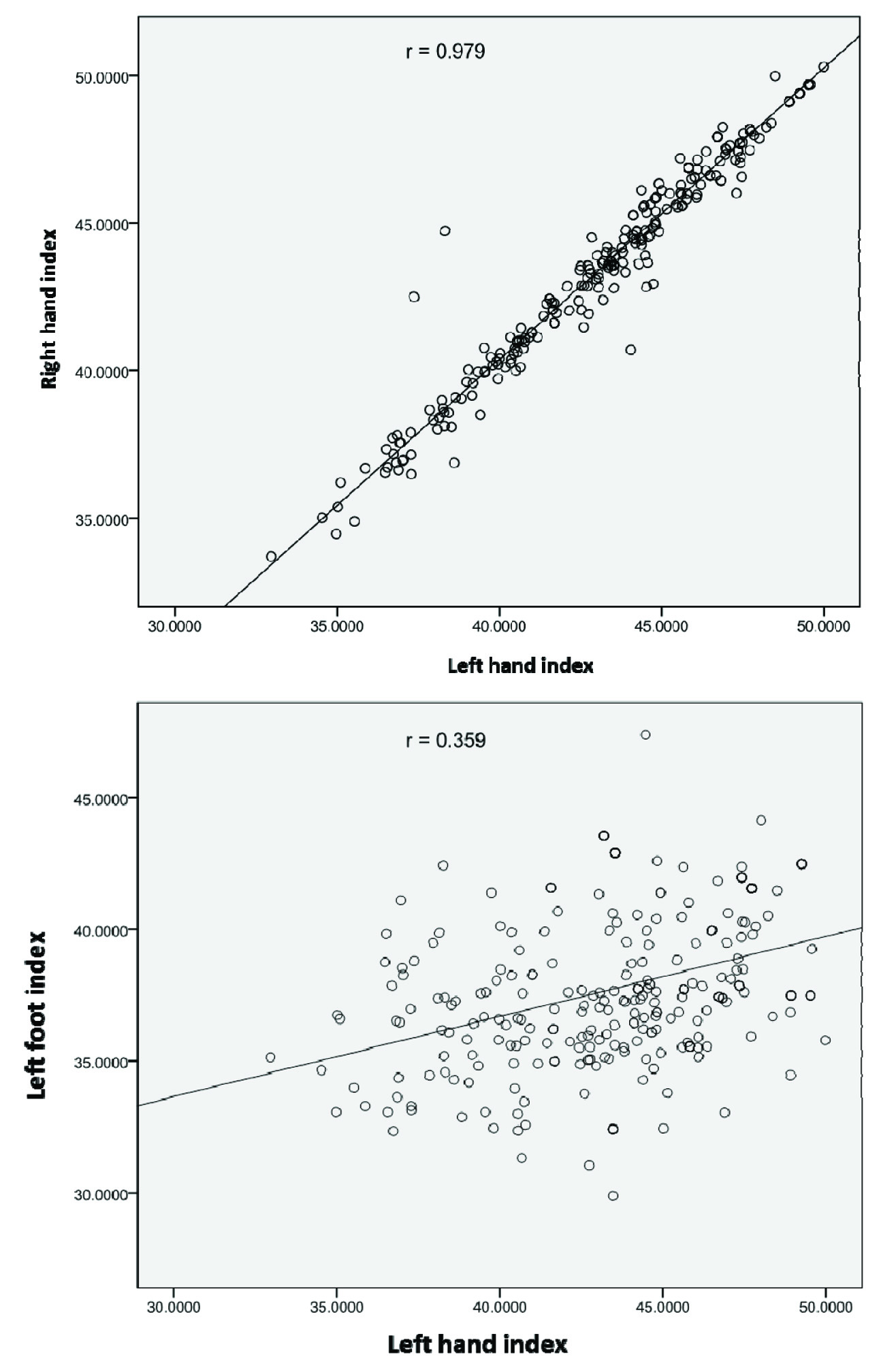
c) Correlation between left hand index versus right foot index; d) Correlation between right hand index versus left foot index.
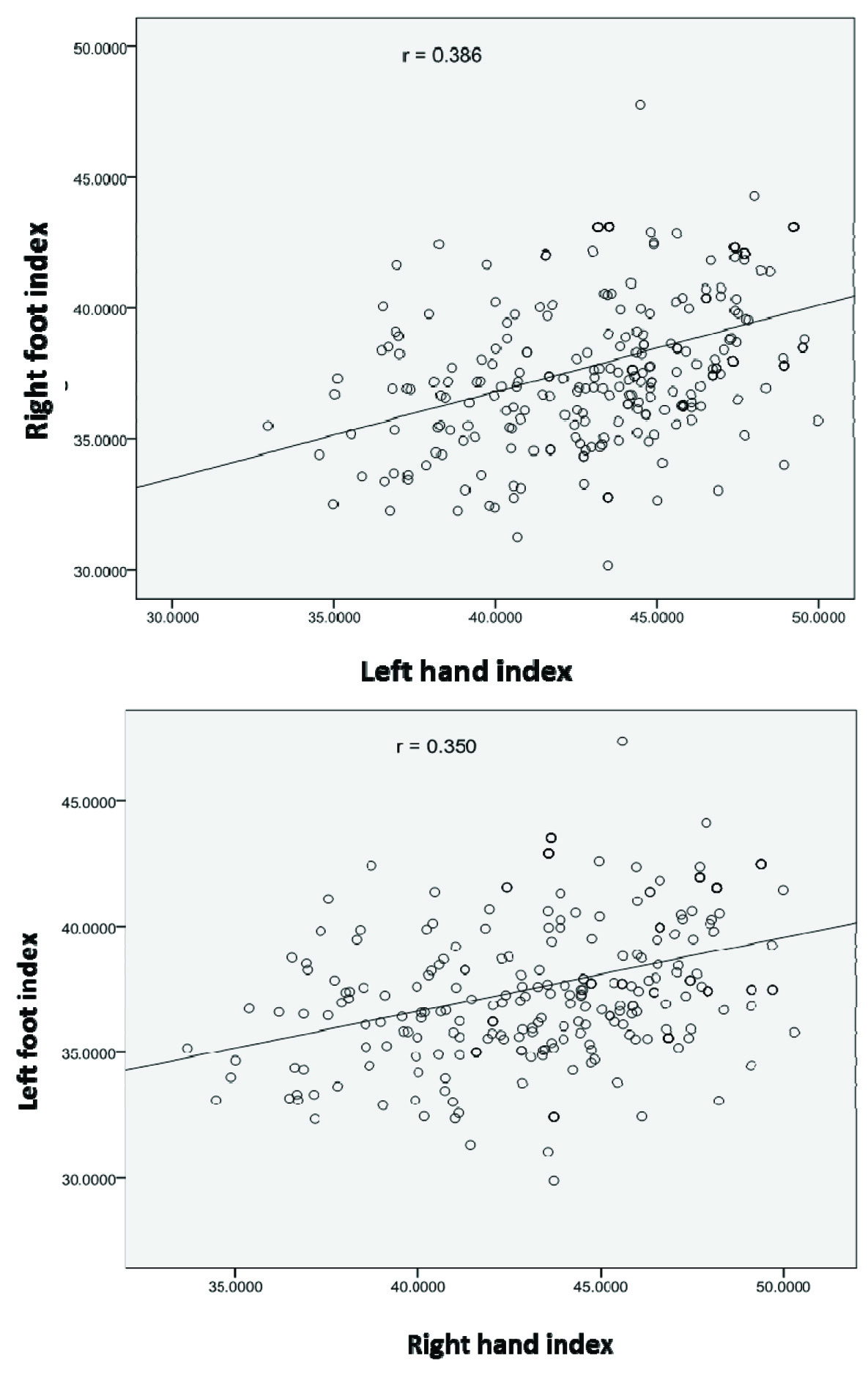
e) Correlation between right hand index versus right foot index; f) Correlation between right foot index versus left foot index.
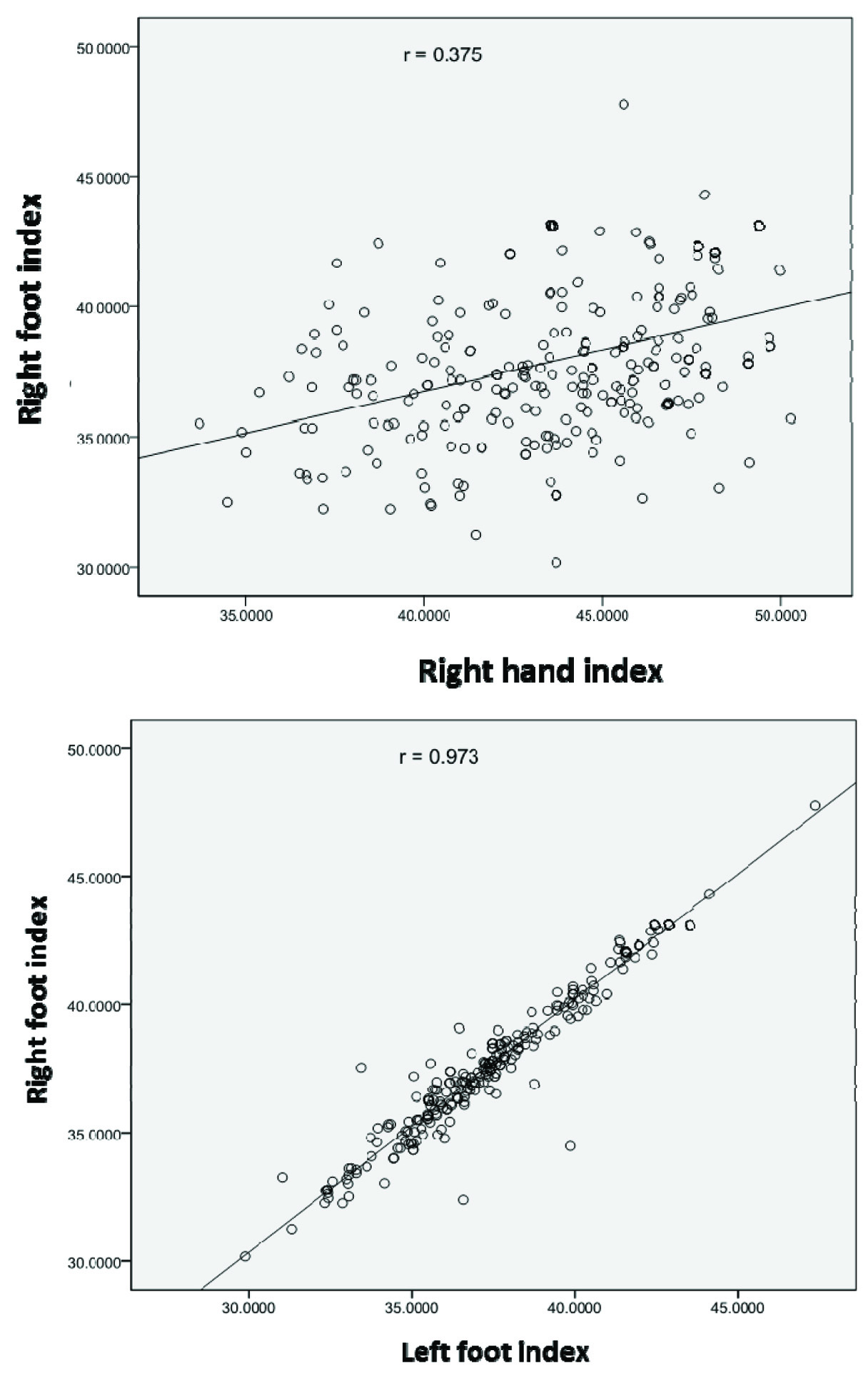
Discussion
Sometimes human bodies are damaged so badly that only pieces of body parts are recovered. In such cases, establishment of identity is a big challenge for the forensic scientist in solving various medico-legal issues. Several techniques are commonly used in forensic anthropology for the identification of an individual like DNA technology etc., In our study, an attempt had been made to determine the sexual dimorphism of index/ring finger length ratio, hand and foot index, as well as the correlation between hand and foot index.
We found that index and ring fingers were significantly longer in males as compared to females and similar findings were encountered by Sen J et al., [10]. In males, the index finger length was found to be significantly (p ≤ 0.001) shorter than that of ring finger length for both hands [Table/Fig-4]. A study carried out by Aboul-Hagag KE et al., in 2011, Kanchan T et al., and Ibrahim MA et al., found that the index and ring finger were almost equal in length in females but males had longer ring fingers [1,3,11]. In our study, the mean index and ring finger length ratio in females were significantly (p≤0.001) higher than in males for both hands. Our findings were in accordance with the results obtained by Aboul-Hagag KE et al., Kanchan T et al., Ibrahim MA et al., and Bailey AA and Hurd PL [1,3,11,12]. We also noticed that the mean index and ring finger length ratio were identical in both left and right hand in males as well as in females [Table/Fig-4]. On contrary, Sen J et al., reported with non-significant mean index and ring finger length ratio for both hands [10]. Barrett CK and Case DT putforth in their study that 2D:4D digit ratios might be population specific and could be an inappropriate tool for determining the gender of an individual [13]. In our study, index and ring finger length ratio for males was seen to be ≤ 0.99 and for females was found to be ≥ 0.99 for both the hands. These findings were similar to the study done by Aboul-Hagag KE et al., and Kanchan T et al., [1,3].
In the present study, the right hand dimensions (i.e., hand length, hand breadth and hand index) were reported to be significantly (p ≤ 0.001) higher in males as compared to females [Table/Fig-6]. The results of our study were similar to the findings of Aboul-Hagag KE et al., Krishan T et al., Ibrahim MA et al., Varu PR et al., Dey S and Kapoor AK, Asha RK et al., Kanchan T and Rastogi P found that female hand dimensions were consistently lower than male hand dimensions in different human populations [1,4,11,14-17]. A cutoff point index ≤ 43.41 was suggestive of females and cutoff point index ≥ 43.41 was indicative of males for both the hands, whereas in the study done by Aboul-Hagag KE et al., determined a cutoff point index of ≤ 40.55 for females and ≥ 40.55 for males [1]. Cutoff point index of ≤ 42 was indicative of females and ≥ 42 was indicative of males for right and left hand as observed by Varu PR et al., in 2016 in their research [14].
In our study, the foot dimensions (i.e., foot length, foot breadth) were found to be significantly (p≤0.001) larger in males than in females on the right side [Table/Fig-6]. Our findings were contrary to the results obtained by Sen J et al., who found that foot length was longer on the left side as compared to the right side and non-significant differences were obtained in males and females between right and left side with foot breadth [18]. Foot index was found to be significantly higher in males on the right side as compared to females [Table/Fig-6]. Our results were contradictory with the study done by Moudgil R et al., who observed that the foot index was found to be slightly larger in females on the right side whereas in males, foot index was greater on the left side [2]. We found that the cutoff point index for females to be ≤ 37.60 and for males to be ≥ 37.60 for both the feet, whereas other studies in the literature have not mentioned the cutoff point index for both the feet.
A statistically significant (p-value<0.001) correlation was found between hand index versus foot index [Table/Fig-7,8a-f]. A strong correlation was between left hand index versus right hand index and right foot index versus left foot index whereas a weak correlation was determined between left hand index versus left foot index, left hand index versus right foot index, right hand index versus left foot index and right hand index versus right foot index.
Limitation
The limitation of this study was that the sample size was small and the study population was limited to dental students and professionals, so the views received could be different from those of the specific population. Further studies on a larger sample should be conducted to confirm the findings of our study and to evaluate whether index/ring finger length ratio, hand and foot index along with their correlation can be used as a valuable tools in gender identification of an individual.
Conclusion
Thus, we found that the mean index and ring finger ratio was found to be significantly lesser in males whereas males showed higher mean values in hand and foot index as compared to females. This study will be valuable in estimating the gender of a dismembered and mutilated hand or foot found at the criminal sites or mass disasters. It may aid in the identification of the victim and hence in ultimately convicting the accused.
*p ≤ 0.001 (for corresponding male-female values) SD- Standard deviation, SE- Standard error of mean, SP- Sectioning point, IFL-Index finger length, RFL-Ring finger length
*p ≤ 0.001 (for corresponding male-female values), SD- Standard deviation, SE- Standard error of mean, SP- Sectioning point
*p ≤0.001 (for corresponding male-female values), SD- Standard deviation, SE- Standard error of mean, SP- Sectioning point
LHI- Left hand index, RHI- Right hand index, LFI- Left foot index, RFI- Right foot index
**indicates correlation is significant at <0.001 level